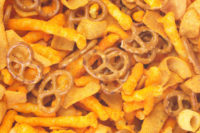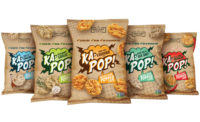Ssshhh … These Snacks Are Private!
By Molly V. Strzelecki
Overall private label snack sales remain relatively flat, but new products are energizing the category.
When it comes to food, deciding what, where and when to eat it has become a delicate mix of art and science. Consumers today are bombarded by messages railing against obesity and promoting more healthful eating.
Although most Americans may have the mindset to eat better on most days, they also are prone to craving an indulgence at any given hour. They have been lectured repeatedly that too much sugar, fat, salt or any other fill-in-the-blank ingredient is not good for you.
But while that’s true, there is a small point that oftentimes gets left out of the equation, and that’s the essential “M” word: moderation.
|
Private Label Category Totals (For 52 weeks ending Aug. 12, 2007) | ||||
| Category | Dollar Sales (in millions) | % Change vs. 2006 | Dollar Share | Dollar Share Change vs. 2006 |
| Snack nuts | $505.9 | +6.8 | 32.1 | +1.1 |
| Cheese snacks | $32.6 | +1.1 | 5.5 | 0.0 |
| Corn snacks | $14.1 | -3.1 | 3.6 | -0.2 |
| Pork rinds | $11.5 | +14.0 | 11.7 | +1.5 |
| Potato chips | $145.9 | +6.4 | 5.2 | +0.4 |
| Pretzels | $76.2 | +12.0 | 12.5 | +1.0 |
| Ready-to-eat popcorn/ caramel corn | $17.6 | +9.1 | 8.1 | +0.4 |
| Tortilla/tostada chips | $103.1 | +9.2 | 5.0 | +0.2 |
| Source: Information Resources, Inc. Total U.S.—Supermarkets, drug stores and mass merchandisers (excluding Wal-Mart) | ||||
Yes, enjoying a little moderate indulgence here or there isn’t going to throw all that good work completely off the rails. And what’s more, companies that are most often frowned upon by health nuts but smiled upon by snack lovers are revamping some of their current products — as well as introducing new ones — to better suit what consumers want.
“Years ago, snack foods, by their nature, were not viewed as health foods,” says Ann Benzel, president of Benzel’s Bretzel Bakery, Altoona, Pa. “Today, to keep shoppers in the snack food aisle, everyone is scrambling to improve their products.”
In the private label realm of snacks, the turn of the grocery cart toward healthier eating hasn’t hurt the industry in the money belt, as retailers and manufacturers are seeing the wealth of opportunities available to them. Not all the numbers are robust, at least according to Chicago-based Information Resources Inc. (IRI), but most categories of private label salty snacks have posted decent gains.
Chipping In
Innovation is driving sales of specific brands in various snack categories says John Frostad, president and chief executive officer of the Vancouver-based Snack Alliance.
“In the industry, we’ve seen some of the highest proliferation [of new products] we’ve ever seen,” he notes. “It’s the new products that are driving the growth, because the baseline potato chips and baseline tortilla chips are relatively flat. New products are coming out and focusing on the health factor.”
Consumers often shudder to think what manufacturers mean by “health factor.” Today, “healthy” often is a codeword for “tasteless.” However, they need not worry, as recent healthful additions actually are more wholesome improvements that make already-tasty products even tastier. These new products often rely heavily on inclusions, as well as out-of-the-ordinary vegetables.
“A lot of companies are moving away from flavoring products and going to inclusions,” says Margaret Garcia, vice president of sales and marketing of San Jose, Calif.-based R.W. Garcia. “They’re including things like flaxseed, sesame seeds, dehydrated vegetable powders and other ‘better-for-you’ ingredients.”
“Snacks from unusual vegetables are becoming popular, as well,” adds Sue Jacobs, an independent marketing consultant for New York’s Home Plate Marketing, which specializes in natural and specialty foods. She notes that national brands such as Hain-Celestial’s Terra Chips have introduced a beet chip, and private label snacks are not far behind. In the pretzel category, for instance, whole grain and high-fiber products are grabbing consumers’ attention.
Additionally, new flavors always are ready to lend a helping hand to spice up category demand.
Paul Smith, director of marketing and product management for Brewster, Ohio-based Shearer’s Foods, Inc., explains that many of the new flavors it promotes in its branded products have been transferred over to its private label offerings.
“Flavors like black bean and salsa, which is on a whole grain, have had a lot of interest from private label [customers],” Smith says. “We launched our Buffalo Blue Cheese last year in branded, and it’s a strong performer, and being picked up in private label this year. Also, our chipotle cheese flavor is coming into private label.”
Private label customers, he adds, have shown an interest in products that can claim reduced- and low-sodium claims, which is something Shearer’s continues to work on as it makes improvements to meet requests.
Salt of the Earth
A host of new products reflects another aspect of the category that’s hot on consumers’ lists: organic and natural products.
“As retailers craft their programs, they’re making significant strategic commitments to their own brand that we haven’t seen before,” Smith says. “They’re looking to make their own private label brands extend into organic for the first time. When they do that, they’re also looking for products that taste great and meet the needs of those new lines.”
Consumers are more accepting of organic snacks, Jacobs notes.
“The fact that they can purchase an organic salty snack at a lower price than the branded has made huge inroads,” Jacobs says.
“People are being educated, and they’re taking their knowledge to the store and comparing bags,” she explains. “When they see three flavors of a private label organic pretzel right next to the branded, it helps build that brand recognition for the store and build consumer loyalty.”
Joe Papiri, vice president of sales and marketing for Snak King Corp., City of Industry, Calif., perceives organic and natural snacks as a consistently growing niche.
“The natural and organic niche continues to expand, folding into the gourmet and super-premium categories, along with the interest in whole grains and lower-fat offerings that still deliver taste,” he says.
A rectangle may be a square, but a square is not a rectangle. Along that same vein, organic may be natural, but natural is not organic. To produce a certified-organic product takes a great deal of work and costs significantly more than non-organic, natural product. As a result, natural salty snack products have seen an upswing with manufacturers and consumers.
“Organics have slowed down a bit because of the premium required on the product,” Frostad says. “There are organic potato chips and tortilla chips and so on, but what we’ve seen is that organic used to mean there was an assurance that consumers could get a product that was healthy or of natural ingredients. Now, there’s not just organic, but a whole industry being created on the natural side, using cleaner ingredients that are pesticide-free. And that’s coming up at a fairly rapid rate.
“It used to be if you wanted natural, you had to go organic,” Frostad continues. “Natural offerings are competing with organic a little bit, and we’re seeing an advanced snacking platform. From a manufacturer’s standpoint, the cost of producing an organic versus a natural product is night and day. It’s less costly to produce a natural product, and therefore you’re gong to see the natural category continue on with good growth, whereas organic may level out.”
Snack on This
Since snacking will always be popular, retailers have a solid consumer base. Private label buyers are vocal about what they want This, combined with retailers’ willingness to step a little outside the box, continues to drive innovation in private label snacks.
“The category is being driven from both the retail and manufacturing side,” Papiri says. “Retailers are increasingly open to pushing the envelope on new snack concepts and flavors. Consumer demand is increasing from the extent of the exposure the retailer is giving these emerging categories.”
Smith agrees retailers are key to turbo-charging the growth in many snack segments.
“The category is primarily driven by the retailers making a concentrated focus and realizing that within the world of private label, the U.S. has the opportunity to reach levels of penetration like Canada and Europe within this category,” he says. “Retailers are seeing that there is business to be had [in private label], and if they’re going to commit time and resources, we want to service our customers with snacks that taste great and are at a great value.”
Smith also notes that the idea of indulgent and gourmet snacking will continue to push the category.
“Gone are the days of black-and-white generic,” he explains. “It’s really about a retailer taking a position. If a retailer is willing to go after indulgence and gourmet, a consumer is willing to accept that in private label.”
With new products and new emerging areas of private label salty snacks, the category is poised for growth, manufacturers agree.
There is no question that on-the-go eating will grow the snack category, Frostad says.
“People are still time-starved,” he explains. “Life keeps growing. Portability of snacking is accelerating, and the category will continue to grow.”
Private label will continue to grow if retailers target new consumers and snack producers meet or surpass their branded counterparts in quality.
“When retailers combine that with putting their marketing money behind their own store brand, that combination will trump it,” Jacobs says.
Despite the hype over health, adds Benzel, salty snacks continue to enjoy unprecedented popularity.
“Everyone in the industry continues to seek ways of satisfying the public’s current cravings in the area of salty snacks,” she continues. “Today’s trendy flavors, such as wasabi, lime or black pepper add excitement in chip selections, and manufacturers have added flavor and fire to tortilla chips and corn snacks, while pretzels, popcorn and nuts have been dipped in chocolate. New product innovation will continue to drive sales in the salted snacks category, although for now, the real lifeblood is products whose formulations focus on health and wellness.”
This Little Piggy Went to Market
Although sales of private label salty snacks generally have been flat, one category has had experienced consistent growth ever since a little trend called the Atkins diet hit the airwaves a few years back. That category is pork rinds.
Go back in 2004, when the world — at least those in the world adhering to the no-carb, high-protein diet — was shocked, amazed and quite a bit pleased to discover that pork rinds were sanctioned as a good snack to eat.
Free from carbohydrates and high in protein, the crispy snack enjoyed a heyday like never before. Even though most no-carb loyalists have fallen by the wayside, pork rinds — especially in private label — still are enjoying strong sales growth.
“That low-carb consumer is still out there and still very engaged in making sure they’re aware of what their carbohydrate intake is,” says Mark Singleton, vice president of sales for Lima, Ohio-based Rudolph Foods. “We have a good story to tell. We’re zero trans fats, zero carbs, and we’re fairly low in saturated fats. Also, 43% of our fat is oleic acid, which is the same [type of fat] as in tuna.”
In the pork rinds subcategory, Singleton notes, the low-carb craze opened a lot of grocers’ eyes to the fact that pork rinds were under-faced on store shelves. Now the products are hitting the second, third or fourth shelf. Retailers are seeing that the crunchy snacks are a hit with consumers, which has allowed manufacturers to expand into different bag sizes bags while expanding profits.
“The private label value proposition appeals to a lot of our direct consumer base who are trying to get the same level or an enhanced level of value, taste, and quality that people have come to expect from private label goods,” Singleton says. “There was a time when private label was thought of as an ‘off’ brand, but that’s so far in our past. The people who are buying private label know that they are going to get top-quality goods and great products and some of the same flavor innovations that they get in branded labels.”
In fact, the private label pork rind is doing so well for Rudolph Foods, Singleton adds, that in some markets, it is the No. 1 seller in the greater snack category.
So it really is true that this little piggy is going “Whee! Whee! Whee!” all the way home … or at least all the way to the piggybank.





